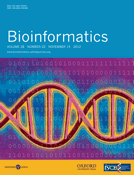
Bioinformatics Advances
Scope & Guideline
Pioneering Discoveries in Genomic Data Analytics
Introduction
Aims and Scopes
- Computational Biology:
The journal publishes studies that utilize computational methods to model biological systems, analyze genomic data, and predict biological outcomes. This includes the development of algorithms for sequence alignment, gene prediction, and molecular dynamics. - Genomics and Transcriptomics:
Research in this area focuses on the analysis of genomes and transcriptomes, employing techniques like RNA-seq and DNA sequencing to uncover genetic variations and their implications in health and disease. - Proteomics and Metabolomics:
Bioinformatics Advances covers studies that analyze protein structures, functions, and interactions, along with metabolomic data, providing insights into cellular processes and metabolic pathways. - Machine Learning and Artificial Intelligence:
The journal highlights the application of machine learning and AI techniques in bioinformatics, including predictive modeling, classification of biological data, and the integration of multi-omics datasets. - Network Biology:
Publications often explore biological networks, such as protein-protein interaction networks, gene regulatory networks, and metabolic pathways, to understand complex biological interactions and systems. - Data Integration and Visualization:
The journal emphasizes tools and methodologies for integrating diverse biological data types and effective visualization techniques that aid in interpreting complex datasets.
Trending and Emerging
- Integrative Multi-Omics Approaches:
There is a significant rise in studies that integrate various omics data (genomics, transcriptomics, proteomics, metabolomics) to provide a holistic view of biological systems, enhancing the understanding of complex diseases. - Deep Learning and AI Applications:
The application of deep learning and AI techniques in bioinformatics is trending upward, focusing on predictive modeling, data classification, and enhancing the accuracy of biological predictions. - Spatial Transcriptomics:
Emerging research in spatial transcriptomics is gaining traction, allowing scientists to analyze gene expression within the context of tissue architecture, which is crucial for understanding developmental biology and disease mechanisms. - Single-Cell Analysis:
The field is increasingly focused on single-cell sequencing technologies, which facilitate the study of cellular heterogeneity and dynamics, providing insights into individual cell behaviors and interactions. - Interactive Visualization Tools:
There is a growing emphasis on developing interactive visualization tools that allow researchers to explore complex datasets in an intuitive manner, enhancing data interpretation and analysis.
Declining or Waning
- Traditional Sequence Alignment Methods:
There appears to be a waning interest in traditional sequence alignment methods, as newer, more efficient algorithms and tools are being developed that leverage machine learning and deep learning techniques. - Static Bioinformatics Tools:
There is a noticeable decline in publications centered around static bioinformatics tools that do not incorporate user interactivity or do not adapt to evolving datasets, as researchers increasingly favor dynamic and user-friendly applications. - Basic Bioinformatics Education:
Fewer papers are focusing on the educational aspects of bioinformatics, such as introductory tutorials or basic software usage, reflecting a possible shift towards more advanced and specialized topics.
Similar Journals

Algorithms for Molecular Biology
Empowering researchers with open access to transformative methodologies.Algorithms for Molecular Biology, published by BMC, is a premier Open Access journal dedicated to advancing the field of molecular biology through innovative computational methods. Since its inception in 2006, the journal has provided a vital platform for researchers to share their findings and methodologies, covering a diverse range of topics at the intersection of applied mathematics, computational theory, and molecular biology. With a notable impact factor reflected in its Scopus ranks, including a Q2 classification in both applied mathematics and computational theory, as well as Q3 in molecular and structural biology, the journal plays an essential role in this rapidly evolving discipline. The wide accessibility of articles published under the Open Access model ensures that research findings reach a global audience, fostering collaboration and innovation amongst scientists and professionals alike. As we look towards converging years from 2006 to 2024, Algorithms for Molecular Biology continues to uphold the highest standards of scientific integrity and excellence, reinforcing its status as a key resource for those engaged in the profound complexities of molecular biology.

BRIEFINGS IN BIOINFORMATICS
Empowering Research with Cutting-Edge BioinformaticsBRIEFINGS IN BIOINFORMATICS is a premier academic journal dedicated to the dynamic field of bioinformatics, published by Oxford University Press. With a prestigious standing reflected in its Q1 quartile rankings in both Information Systems and Molecular Biology, this journal serves as an essential resource for researchers, professionals, and students eager to explore the intersection of biology and computational sciences. The journal not only publishes high-impact research articles but also reviews and critical commentaries that push the boundaries of understanding in bioinformatics. As it converges its objectives towards fostering innovation and knowledge dissemination from 2000 to 2024, BRIEFINGS IN BIOINFORMATICS offers rich insights that remain pivotal to advancements in genomic studies, data integration, and computational tools. Its ranking in the top percentiles of Scopus—30th among 394 in Computer Science and 44th among 410 in Molecular Biology—underscores the journal's influential presence in the academic community. Engaging with the latest research and trends, this journal is integral for anyone invested in the future of life sciences and data analytics.

Briefings in Functional Genomics
Unveiling the Complexities of Molecular BiologyBriefings in Functional Genomics, published by Oxford University Press, serves as a crucial academic resource in the fields of biochemistry, genetics, and molecular biology. With an ISSN of 2041-2649 and an E-ISSN of 2041-2657, this esteemed journal explores innovative research and developments in functional genomics, with a commitment to advancing our understanding of genetic processes and their implications in health and disease. Ranking in the Q2 quartile for both Biochemistry and Genetics, and occupying a prominent Q1 status in the domain of interdisciplinary Medicine, the journal is positioned as a leading platform for researchers seeking to disseminate their findings to a global audience. Although it does not currently offer open access options, its accessibility through institutional subscriptions and its esteemed impact factor underscore its importance in the research community. Covering converging topics from 2010 to 2024, Briefings in Functional Genomics not only keeps pace with the rapidly evolving landscape of genomics but also stimulates collaboration and dialogue among scientists and industry professionals alike, making it an indispensable tool for researchers, practitioners, and students eager to engage with cutting-edge genomic science.

BioData Mining
Advancing Knowledge at the Intersection of Biology and TechnologyBioData Mining is a distinguished open access journal published by BMC, focusing on the dynamic intersection of bioinformatics, computational mathematics, and molecular biology. Since its inception in 2008, this journal has provided a critical platform for researchers and professionals to publish their findings, contributing significantly to the collective knowledge in fields such as biochemistry, computational theory, and genetics. With a robust impact factor and a commendable h-index, BioData Mining continues to be a vital resource for academic and industrial advancements, ranked in the top quartiles in various categories according to the 2023 metrics. The journal's commitment to open access ensures that cutting-edge research is readily available to the global scientific community, thereby enhancing visibility and fostering collaboration among scholars. Whether you are a researcher, student, or practitioner, engaging with BioData Mining will equip you with relevant insights and developments in the fast-evolving realm of bioinformatics.

Bioinformatics and Biology Insights
Fostering collaboration at the forefront of biological research.Bioinformatics and Biology Insights is a premier open-access journal dedicated to advancing the frontiers of bioinformatics and biology. Published by SAGE Publications Ltd, this journal is a leading platform for disseminating high-quality research that integrates computational methods with biological insights. Since its inception in 2007, the journal has garnered significant recognition, reflecting its commitment to excellence, as evidenced by its impressive impact factor and a strong presence across multiple quartiles in applied mathematics, biochemistry, and computational sciences. With a rank of Q1 in both Applied Mathematics and Computational Mathematics and various other notable rankings in related fields, it serves as an essential resource for researchers, professionals, and students seeking cutting-edge knowledge and innovations. The journal's open-access model ensures that findings are readily available, fostering collaboration and advancement in this dynamic field. Through its comprehensive scope and rigorous peer-review process, Bioinformatics and Biology Insights continues to play a pivotal role in shaping the future of biological research and computational methodologies.

Cell Systems
Pioneering Discoveries in Systems BiologyCell Systems is an esteemed journal published by CELL PRESS, dedicated to advancing the field of systems biology and its applications in cell biology, histology, and pathology. Since its inception in 2015, it has quickly ascended to a prominent position within the academic community, currently holding a Q1 ranking across multiple categories including Cell Biology, Histology, and Pathology and Forensic Medicine for 2023. With an impressive Scopus ranking—third in Medicine: Pathology and Forensic Medicine, and similarly high standing in Histology—it serves as a key resource for researchers and professionals aiming to explore and disseminate cutting-edge research findings. The journal provides an open-access platform, making it an accessible source of knowledge for students and scholars alike, fostering collaboration and innovation within the dynamic landscape of cellular research. With a commitment to high-quality and impactful publications, Cell Systems plays a pivotal role in shaping the future of biological sciences.

BIOINFORMATICS
Connecting Biology and Technology for a Sustainable FutureBIOINFORMATICS, published by Oxford University Press, is a leading journal in the realms of biochemistry, computational mathematics, and computer science, with a notable impact factor that underscores its significance in the field. Since its inception in 1985 and continuing through its expected convergence in 2024, the journal has maintained a prestigious reputation, proudly residing in the Q1 category across multiple disciplines, including molecular biology and statistics. With a Scopus ranking placing it within the top percentiles of its categories, BIOINFORMATICS serves as an essential platform for disseminating high-quality research that advances knowledge and innovation at the intersection of biology and computational sciences. This journal not only offers both subscription and open access options, ensuring wider availability of its cutting-edge research, but it has also become a crucial resource for researchers, professionals, and students aiming to stay at the forefront of bioinformatics and related fields. Explore the latest findings and trends that define the future of biological research through this esteemed publication, any inquiries regarding the journal can be directed to its offices located at Great Clarendon St, Oxford OX2 6DP, England.

Database-The Journal of Biological Databases and Curation
Navigating the Complexities of Biological Data with ExpertiseDatabase - The Journal of Biological Databases and Curation, published by Oxford University Press, stands at the forefront of the rapidly evolving fields of biological data management and curation. Since its inception in 2009, this open access journal has become a pivotal resource for researchers and professionals eager to explore the intricate world of biological databases. With an impressive impact factor, it ranks in the Q1 quartile across significant disciplines such as Agricultural and Biological Sciences, Biochemistry, Genetics and Molecular Biology, Information Systems, and Medicine as of 2023. This prestigious standing reflects its commitment to high-quality research and innovation. The journal not only provides a platform for original research articles, reviews, and case studies but also aims to facilitate discussion on best practices in database design and curation. By bridging the gap between data generation and utilization, it plays an essential role in enhancing the accessibility and usability of biological data, making it indispensable for scholars and students who are navigating these complex domains.

FUNCTIONAL & INTEGRATIVE GENOMICS
Innovating Insights into Genetic IntegrationFUNCTIONAL & INTEGRATIVE GENOMICS, published by Springer Heidelberg, is a leading journal in the fields of genetics and molecular biology. Established in 2000, it serves as a pivotal platform for advancing our understanding of genomic functionality and integration, making significant contributions to both basic and applied research in genetics. With a robust impact factor and a ranking in the Q3 quartile for Genetics and Q2 for Medicine (Miscellaneous), the journal aims to publish innovative research that explores the relationships between genomic data and biological functions, appealing to a diverse audience of researchers and professionals. Although it operates under a subscription model, the journal's extensive archives remain a valuable resource for academics seeking to stay abreast of the latest findings and methodologies in genomics. As the field evolves, FUNCTIONAL & INTEGRATIVE GENOMICS remains committed to fostering scholarly dialogue and the dissemination of groundbreaking studies that influence future research trajectories.

JOURNAL OF COMPUTATIONAL BIOLOGY
Advancing the Frontiers of Biology through ComputationJOURNAL OF COMPUTATIONAL BIOLOGY, published by Mary Ann Liebert, Inc., serves as a premier platform for the dissemination of groundbreaking research at the intersection of biological sciences and computational methods. Established in 1994, this journal provides a valuable resource for researchers, professionals, and students interested in the evolving fields of computational mathematics and biology. With a commendable Q2 ranking in several pertinent categories such as Computational Mathematics and Modeling and Simulation, it emphasizes high-quality studies that propel understanding and innovation in these areas. Although the journal currently operates under traditional access options, it plays a crucial role in fostering scholarly communication and collaboration among a diverse audience, advancing knowledge in genetics, molecular biology, and beyond. The journal's continual evolution, with a commitment to publish until at least 2024, positions it as a critical resource in the fast-paced world of computational biology.